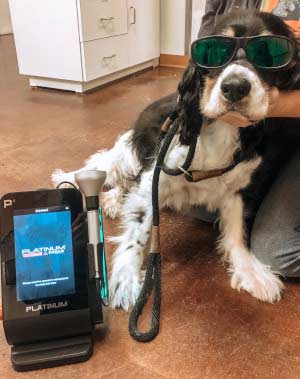Benefits of Therapeutic Laser

Pets are living longer, happier lives as a result of routine preventive care and advancements in medical technology. Laser therapy is another tool for treating and managing a wide variety of conditions in pets.
The History of Laser
The therapeutic laser was developed in 1960 with documented use in pets in 1967. In the 1970s, it was accepted as a physical therapy modality. As more studies have been carried out, interest in therapeutic laser for treating various conditions has grown dramatically. Therapeutic laser can be used in conjunction with, or instead of medication to manage pain, inflammation, and wound healing. This is similar to acupuncture, massage therapy, and other alternative therapies.
Technology Behind Laser
Therapeutic lasers use light waves of a specific wavelength to cause photobiomodulation, or the alteration of cellular and tissue physiology. Light absorbed by cellular components stimulates electrons and activates cells to promote growth, proliferation, migration, and repair. Laser therapy helps tissue repair by causing the following:
- Endorphin release
- Vasodilation, which increases blood flow to bring in oxygen and cells involved in the healing process
- Muscle relaxation
- Decreased inflammation
- Faster healing and repair
The main clinical benefits of laser use in pets include decreased inflammation, decreased pain, and improved wound healing.

Use of Laser
Laser therapy is used to treat or manage many pet medical conditions, including: arthritis, surgical incisions, tendon or ligament injuries, ear infections, wounds and infections. At ZimmVet the most common uses are to speed up post-surgical healing, aid in treatment of chronic arthritis and chronic wounds or lick granulomas. Laser therapy should not be used on pregnant animals or in pets that have cancer. A veterinarian can help you decide if laser therapy would be a good option for your pet.
What to Expect
During a treatment session, the handheld wand of the laser unit is slowly moved back and forth over the damaged tissue. Most pets experience a warm, pleasant sensation and find treatment sessions relaxing. Sessions usually last 15 to 30 minutes, with the number of sessions and treatment frequency dependent on the injury. Chronic conditions may be treated weekly, whereas surgical incisions and open wounds often require treatment daily.
For more information, please visit Summus™ Laser.


